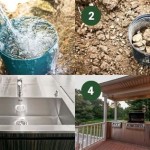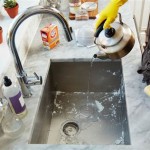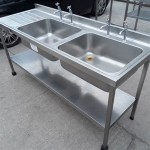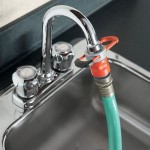Faucets For The Kitchen Sink: A Comprehensive Guide
The kitchen sink faucet, more than just a plumbing fixture, is a focal point of the kitchen. Daily tasks from washing dishes to rinsing produce rely on its functionality and design. Selecting the right faucet involves considering several factors, including style, features, material, and budget. A well-chosen faucet can enhance the efficiency and aesthetics of the kitchen, while a poorly chosen one can lead to frustration and potential plumbing issues.
This article aims to provide a comprehensive overview of kitchen sink faucets, covering different types, key features, materials, installation considerations, and maintenance tips. Understanding these aspects will enable homeowners to make informed decisions when choosing a faucet that best suits their needs and preferences.
Types of Kitchen Sink Faucets
The market offers a diverse range of kitchen sink faucets, each designed with specific features and functionalities. Understanding the different types is crucial for selecting a faucet that aligns with the kitchen's design and the user's requirements.
Pull-Down Faucets: Pull-down faucets feature a spray head that detaches from the spout and can be pulled down into the sink. These faucets offer excellent reach and flexibility, making them ideal for washing large pots and pans or rinsing the sink. The retractable hose allows for easy maneuverability, and most models include multiple spray settings, such as a stream, spray, and pause function. The weight on the hose helps retract it to the original position.
Pull-Out Faucets: Similar to pull-down faucets, pull-out faucets also have a detachable spray head. However, instead of pulling down, the spray head pulls out horizontally from the spout. Pull-out faucets are generally more compact than pull-down models, making them suitable for smaller sinks or kitchens with limited space. They are also typically easier to install since they don't require as much clearance beneath the sink.
Single-Handle Faucets: Single-handle faucets are characterized by a single lever that controls both water temperature and flow. They are known for their ease of use and streamlined design. Adjusting the temperature and flow with one hand allows for convenience during tasks. Single-handle faucets are available in a variety of styles, from traditional to modern, and are a popular choice for many kitchens.
Double-Handle Faucets: Double-handle faucets feature two separate handles, one for hot water and one for cold water. This traditional design offers precise control over water temperature, allowing the user to mix hot and cold water to achieve the desired temperature. Double-handle faucets are often chosen for their classic aesthetic and durability. They may require more space on the countertop compared to single-handle models.
Bridge Faucets: Bridge faucets connect the hot and cold water valves with a visible horizontal bar, creating a distinctive and elegant look. These faucets are typically mounted on the countertop and add a touch of vintage charm to the kitchen. Bridge faucets are available in various finishes and styles, often complementing traditional or farmhouse-style kitchens.
Wall-Mount Faucets: Wall-mount faucets are installed directly onto the wall above the sink, rather than on the countertop. This design frees up space on the countertop and creates a clean, minimalist look. Wall-mount faucets require careful planning during installation, as the plumbing must be routed through the wall. They are often used in modern or contemporary kitchens.
Touch and Touchless Faucets: Touch and touchless faucets utilize advanced technology to control water flow. Touch faucets allow the user to turn the water on and off with a simple touch to the faucet body, while touchless faucets use sensors to detect movement and activate the water flow. These faucets enhance hygiene and convenience, as they eliminate the need to touch the faucet with dirty hands. They are particularly useful when cooking or handling raw food.
Key Features and Functionality
Beyond the basic types, kitchen sink faucets offer various features that can enhance their functionality and user experience. These features include spray modes, spout height, and valve technology.
Spray Modes: Many faucets offer multiple spray modes, such as a stream, spray, and pause function. The stream mode is ideal for filling pots and pitchers, while the spray mode is useful for rinsing dishes and produce. The pause function temporarily stops the water flow, which can be convenient when switching between tasks. Some faucets also offer a powerful "boost" spray for removing stubborn food particles.
Spout Height and Reach: The spout height and reach are important considerations, especially when washing large pots and pans. A high-arc spout provides ample clearance for tall items, while a longer reach allows the user to easily access all areas of the sink. Consider the size and depth of the sink when selecting a faucet with appropriate spout height and reach.
Valve Technology: The valve is a critical component of the faucet, controlling the water flow and temperature. Ceramic disc valves are known for their durability and leak-resistant performance. They provide a smooth and precise control over water flow and are less prone to wear and tear compared to traditional compression valves. Compression valves, while more affordable, tend to require more maintenance and may be prone to drips over time. Ball valves are another option, offering a durable and reliable performance.
Water Efficiency: Water-efficient faucets help conserve water and reduce utility bills. Look for faucets with a WaterSense label, which indicates that they meet the Environmental Protection Agency's (EPA) criteria for water efficiency. These faucets typically have a flow rate of 1.5 gallons per minute (GPM) or less, compared to standard faucets that may have a flow rate of 2.2 GPM or higher.
Filtration Systems: Some faucets come with integrated filtration systems that provide clean and purified water directly from the tap. These systems typically use filters to remove contaminants such as chlorine, lead, and sediment, improving the taste and quality of the water. Filtration faucets can be a convenient alternative to separate water filter pitchers or under-sink filtration systems.
Materials and Finishes
The material and finish of a kitchen sink faucet significantly impact its durability, aesthetics, and maintenance requirements. Selecting a material and finish that complements the kitchen's design and withstands daily use is essential.
Brass: Brass is a popular material for faucet construction due to its durability and resistance to corrosion. It can withstand high water pressure and temperature fluctuations without deteriorating. Brass faucets are often coated with a finish to enhance their appearance and protect them from tarnishing.
Stainless Steel: Stainless steel is another durable and corrosion-resistant material commonly used in faucet manufacturing. It is known for its sleek and modern look, as well as its resistance to scratches and stains. Stainless steel faucets are easy to clean and maintain, making them a practical choice for busy kitchens.
Zinc Alloy: Zinc alloy is a more affordable alternative to brass and stainless steel. While it is less durable than these materials, it can still provide adequate performance for many applications. Zinc alloy faucets are often coated with a finish to improve their appearance and protect them from corrosion.
Finishes: Faucet finishes not only enhance the appearance of the faucet but also provide a protective layer against wear and tear. Common finishes include chrome, brushed nickel, oil-rubbed bronze, and matte black. Chrome is a classic and durable finish that is easy to clean. Brushed nickel offers a softer, more subtle look and is less prone to fingerprints. Oil-rubbed bronze adds a touch of warmth and elegance to the kitchen. Matte black is a modern and stylish finish that complements contemporary kitchen designs.
Considerations for Material Selection: When choosing a faucet material, consider the water quality in the area. Hard water can cause mineral buildup on faucets, which can affect their performance and appearance. Brass and stainless steel are generally more resistant to mineral buildup than zinc alloy. Also, think about the overall style of the kitchen and choose a material and finish that complements the existing décor.
The selection of the appropriate kitchen faucet involves a thoughtful evaluation of various elements. The functionality, aesthetics, and durability are all important. It is necessary to consider different types, key features and material to make the best choice.

Kitchen Faucets Explore Taps Kohler India

Unlacquered Brass Bridge Kitchen Sink Faucet Antique Vintage 8 Inches Spread In India Etsy

Kitchen Faucet With Pull Down Sprayer 3 Functions Sink Faucets

Latest Kitchen Sink Taps Faucets Design For Wash Basin
-Content-aaf14433:Three-Up-Content-Mobile-Landscape-Giant?strip=all)
Kitchen Faucets Explore Taps Kohler India

How To Choose Your Kitchen Sink Faucet Riverbend Home

Latest Kitchen Sink Taps Faucets Design For Wash Basin

Kitchen Brizo
-Content-aaf14429:Three-Up-Content-Mobile-Landscape-Giant?strip=all)
Kitchen Faucets Explore Taps Kohler India

Clozer Rose Gold Kitchen Faucet Sink Mixer In India







